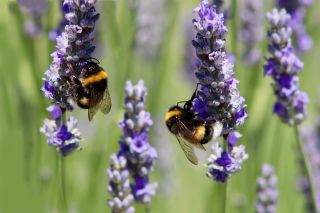Animal Behavior
Bumblebees Learn From Each Other
Can insects have a culture?
Posted June 13, 2024 Reviewed by Michelle Quirk
Key points
- We often underestimate the cognitive abilities of animals such as insects.
- "Cumulative culture" was thought to be a uniquely human ability.
- Bumblebees are able to socially learn behaviors that are too complex to be innovated by a single individual.

In Frank Schaetzing's internationally successful science fiction novel The Swarm, humans are suddenly confronted with an intelligent species of tiny organisms. But biologist Lars Chittka of Queen Mary University in London would say that the extraordinary cognitive abilities of tiny creatures are not science fiction. We often underestimate the cognitive abilities of animals, especially when they are not closely related to us. Chittka's subjects also often live in swarms, but they are not as small as the "Yrr" in Schaetzing's book: He works with insects.
In his latest study, he and his team are looking at cumulative culture in bumblebees, a skill scientists are not even sure chimpanzees are capable of. What was culture again? In a previous post here, we defined it as the long-term transfer of information from one generation to the next, but not through genes. Instead, information is passed on through social learning. Chittka and his team found that bumblebees can indeed learn from each other.
But what is "cumulative" culture? It means that a species can build culturally on what generations before it have learned. It cumulates knowledge or skills and can build on them. So there is no need to reinvent the wheel. Until recently, this was thought to be a uniquely human ability. Now there is some evidence that chimpanzees can do it under certain circumstances (Van Leeuwen et al. 2024)—and so can bumblebees (Bridges et al. 2024).
To study cumulative culture, you need a problem that no single individual can solve. Individuals of the species being tested simply cannot come up with a solution on their own. For the bumblebees, the researchers built a two-step puzzle box with a sucrose solution as a reward on a yellow target. To reach the reward, the insects had to do two things in the correct order: First, move a blue tab, and then press a red tab. Importantly, there was no reward after moving the blue tab, making it very difficult for the bees to learn the task. The researcher presented the insects with this puzzle box for more than two weeks, but not a single bumblebee was able to learn the task on its own.
The next step was to train the demonstrators, but this posed some difficulties. The main problem was that the bees were generally unwilling to perform actions that were not directly linked to a reward or that were no longer rewarded. So another temporary reward had to be added underneath the blue tab, which was later removed.
Eventually, the researchers were able to train demonstrator bees to move the blue tab and then push the red tab. A trained demonstrator was then paired with a naive observer. The two were allowed to forage on three closed puzzle boxes for 30 to 40 sessions of about 20 minutes each. The researchers then tested the observer bees in learning trials in which they were not rewarded. It turned out that 5 out of 15 observers passed the learning test, proving that they had learned the whole task from the demonstrator. This shows two things: First, this task is really difficult for bumblebees, and second, they are able to learn from their conspecifics (Bridges et al. 2024). Interestingly, the little insects outperformed great tits, which were tested in a similar task but did not learn the full two-step behavior from the demonstrator (Wild et al. 2022).
The authors of the study conclude that bumblebees are able to socially learn behaviors that are too complex to be innovated by a single individual. In other words, cumulative culture is not unique to humans.
The results of this study thus teach us the same lesson that was proposed in the novel The Swarm: Remarkable cognitive abilities are not only found in closely related species, they could be out there in the deep ocean or in a black-and-yellow-coated insect.
References
Bridges, A.D., Royka, A., Wilson, T. et al. (2024) Bumblebees socially learn behaviour too complex to innovate alone. Nature 627, 572–578.
van Leeuwen, E.J.C., DeTroy, S.E., Haun, D.B.M. et al. (2024) Chimpanzees use social information to acquire a skill they fail to innovate. Nat Hum Behav 8, 891–902.
Wild, S. et al. (2022) Complex foraging behaviors in wild birds emerge from social learning and recombination of components. Phil. Trans. R. Soc. B 377, 20200307


